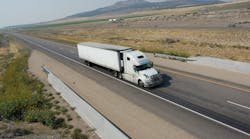John Larkin, managing director and head of transportation capital markets research at Stifel Financial Corp. recently made several predictions regarding the freight transportation and logistics market for the U.S., with tidings both good and grim for trucking companies.
On the plus side, the rise of automation and 3D printing in manufacturing, alongside a growing desire to shorten global supply chains in order to cut costs, should bring more production back to the U.S. and consequently increase freight demand, in his view.
“The U.S. is gaining a competitive advantage as labor costs outside of [America] rise faster than costs in the U.S. are rising. Additionally, horizontal drilling [fracking] has made our energy costs highly competitive globally,” Larkin explained in a research note. “Lastly, accelerating improvements in the worlds of manufacturing automation and 3D printing increase the odds of a re-acceleration in the nearshoring and in-sourcing phenomena [more] actively discussed prior to the relatively recent spike in the value of the U.S. dollar.”
He added that full production of products within the U.S. opens up the opportunity for eight to 12 “touches” by transportation companies, in terms of hauling raw materials, substrate, semi-finished material, finished materials, parts, components, sub-assemblies, and finished products.
That compares favorably to the one to two transportation touches available to domestic companies when goods are produced overseas and them imported to the U.S., Larkin said.
On top of that, as labor costs converge around the world and production is further automated, long supply chains will begin to fall out of favor as shorter, locally sourced, and more “time responsive” supply chains will increasingly become the norm, he pointed out.“Ultimately, rapid delivery of infinitely flexible/tailored products is possible, if not likely, within the next 10 to 20 years,” Larkin (seen at right) predicted. “Of course, the substrate material used by 3D printers will have to be transported into the urban markets by bulk carriers, of which we will likely have too few.”
When all of that, especially an increased need for more “transportation touches,” is superimposed on top of capacity constraints caused by a worsening labor shortage – especially for truck drivers – and what Larkin describes as a “cavalcade” of federal rules and regulations, the stage could be finally set what he’s often described as “the mother of all capacity shortages.”
“Again, capacity shortages enable carriers to select the customers, lanes, and freight that will result in the highest utilization of equipment and labor, the smallest number of empty miles, and the highest unit revenue,” Larkin stressed. “Margins and return on capital should benefit [motor carriers] over the next decade, perhaps dramatically.”
Yet not all of his future projections bode well for trucking, especially when it comes to e-commerce.
Larkin believes e-commerce should continue to grow market share from its current level – some 7.4% of retail sales as of the third quarter of 2015 – with more and more consumers opting to purchase products on-line with desktop or mobile devices.
“And more and more will opt for home delivery, delivery to the trunk of one’s automobile, pick up at a store, or pick up at a nearby point,” he stressed. “The transportation emphasis will therefore be centered around keeping urban fulfillment centers stocked and the high velocity last mile delivery function. [Thus] dedicated and private fleets, focused more on the remote distribution center to store delivery moves, might lose some volume as this e-commerce trend marches on.”
Some other future trends Larkin believes will impact the trucking and logistics include:
- The supply of skilled labor to drive trucks, operate forklifts, maintain aircraft, etc., will almost certainly create a shortage of supply chain capacity over the next decade.
- That shortage will enable logistics services providers – with and without assets – to optimize margins and returns on capital by allocating scarce resources to customers willing to pay the highest price and/or those will to collaborate with supply chain service providers to maximize utilization.
- Regulations could create a capacity crisis heretofore not experienced, with the Obama Administration expected to issue as many regulations as possible in its final full year under the theory that the next administration may not be as supportive of so much federal control of so many aspects of the U.S. economy.
- A “silver bullet” solution to fully automated freight brokerage will continue to prove elusive over the near- to medium-term. A more likely scenario will involve the incremental automation of some of the individual steps involved in the broader truck freight brokerage process.
- The continued migration of consumption, and increasingly production, to the southeast, southwest, and west sections of the U.S. (excluding California, except in the case of Silicon Valley) will keep reshaping transportation and distribution patterns, likely leading to shifts in truck freight lane balance and equipment availability. Motor carriers not dynamically monitoring and adapting their networks to reflect changes in lane balance, equipment utilization rates, empty mile ratios, and pricing could find profitability hurt significantly.




